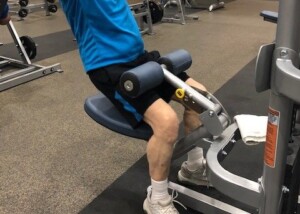
Let’s pit “muscle confusion” against simply lifting heavier and heavier weights for shock value to grow muscles.
“Muscle confusion” was all the rage some years ago, particularly with the P90X program created by trainer Tony Horton.
It has not been proven that the so-called muscle confusion fails to spark hypertrophy in stalled muscle fibers.
On the other hand, there are those who heavily criticize this approach and deem it nothing more than a brilliant marketing gimmick.
When Tony Horton explains what muscle confusion is and how it triggers new growth (hypertrophy) in his infomercials, he’s superb, and it all makes perfect sense.
Critics also point out that many personal trainers have jumped on this bandwagon and in fact, even toss it out indiscriminately as a reason they have their clients doing funky things.
The trainer gets away with saying, “It’s to confuse your muscles,” because this kind of sounds scientific and saves the trainer from having to give a lengthier explanation.
One day I was reading a critic’s take on the whole concept. This guy had huge muscles. He was calling the muscle confusion thing a load of crap.
Then he said, “Want to know how to confuse your muscles? Lift heavier weight.”
Bingo! And as a former personal trainer myself, I’m going to have to side with this dude because, when you really think about it, lifting heavier and heavier weights (progressive resistance over time) IS indeed the best way to confuse your muscles!

Freepik.com
Muscle Confusion vs. Progressive Resistance (Heavier Weights)
Let’s use the lat pull-down as an example. This is pulling movement that recruits the lats and other middle back musculature, and it also engages the biceps and forearms.
Let’s say you’ve been doing this with an amount of weight that allows you to complete around 10 to 12 reps with moderate to challenging effort, but nothing you’d call straining.
You haven’t been doing any horizontal rows, but one day you come upon the muscle confusion concept and ditch the lat pull-downs for seated cable rows with your palms facing each other and a slightly narrower grip.
You’ve changes multiple angles, which, according to the muscle confusion approach, should kick-start hypertrophy.

Freepik/senivpetro
But let’s assume, though, the amount of resistance is comparable to the lat pull-down, in that the effort level is the same with your 10-12 reps.

Freepik
So all you’ve changed were some angles and body positioning, but the level of effort is the same.
Just how “shocked” do you think that your muscles will be?
Now suppose you keep doing the lat pull-down and don’t bother with the seated cable row.
But you change just one thing: the amount of resistance you’re pulling down.
Same angle, same hand position as always, same distance between the hands, same everything — except you’ve increased the resistance by a little over 30 percent.
This means that if your body has adapted to a 105-pound pull for months on end, you’re now pulling 155 pounds.
“Whoa! What’s going on here?” scream your muscles. Same angle, same hand position, same pulling trajectory, same body position, but…BAM! What’s with all the weight?!
Your body is now under fire. You must now wrestle with pulling down that bar, gritting your teeth, straining to complete just seven reps. Every inch lower than forehead level is a battle.
You’d better believe your muscles are friggin’ confused! They will now be forced to adapt to a new training stimulus: not new angles, but heavier resistance.
This will trigger hypertrophy like no mere change of trajectory angle or hand position will.
Now I bet you’re wondering, why not combine progressive resistance with a change in angles and positions?
Certainly that’s a good approach, but I won’t say that the resulting progress in hypertrophy is more from the change in angles than in the comparably heavier resistance.
In other words if you’ve set the weight stack for the seated cable row so heavy that you are straining and struggling to complete six to eight reps (keeping good form!), it’s this new struggle to your body that will trigger hypertrophy.
Your body will not feel under siege by simply switching around some angles and using a different handle.
When it comes to muscle confusion vs. progressive resistance (striving to use heavier and heavier weight over time) for growth, the savvy muscle-building enthusiast will recognize the clear winner here: Lift heavier weight!
 Lorra Garrick is a former personal trainer certified by the American Council on Exercise. At Bally Total Fitness she trained clients of all ages for fat loss, muscle building, fitness and improved health.
Lorra Garrick is a former personal trainer certified by the American Council on Exercise. At Bally Total Fitness she trained clients of all ages for fat loss, muscle building, fitness and improved health.
.

























